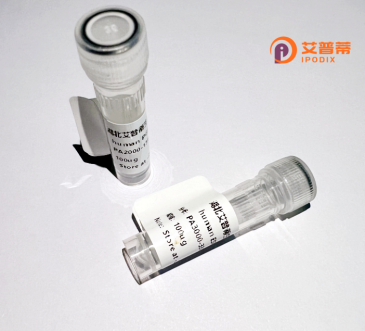
| 纯度 | >90%SDS-PAGE. |
| 种属 | Human |
| 靶点 | C16orf57 |
| Uniprot No | Q9BQ65 |
| 内毒素 | < 0.01EU/μg |
| 表达宿主 | E.coli |
| 表达区间 | 1-265aa |
| 氨基酸序列 | MSAAPLVGYSSSGSEDESEDGMRTRPGDGSHRRGQSPLPRQRFPVPDSVLNMFPGTEEGPEDDSTKHGGRVRTFPHERGNWATHVYVPYEAKEEFLDLLDVLLPHAQTYVPRLVRMKVFHLSLSQSVVLRHHWILPFVQALKARMTSFHRFFFTANQVKIYTNQEKTRTFIGLEVTSGHAQFLDLVSEVDRVMEEFNLTTFYQDPSFHLSLAWCVGDARLQLEGQCLQELQAIVDGFEDAEVLLRVHTEQVRCKSGNKFFSMPLK |
| 分子量 | 56.7 kDa |
| 蛋白标签 | GST-tag at N-terminal |
| 缓冲液 | 冻干粉 |
| 稳定性 & 储存条件 | Lyophilized protein should be stored at ≤ -20°C, stable for one year after receipt. Reconstituted protein solution can be stored at 2-8°C for 2-7 days. Aliquots of reconstituted samples are stable at ≤ -20°C for 3 months. |
| 复溶 | Always centrifuge tubes before opening.Do not mix by vortex or pipetting. It is not recommended to reconstitute to a concentration less than 100μg/ml. Dissolve the lyophilized protein in distilled water. Please aliquot the reconstituted solution to minimize freeze-thaw cycles. |
以下是关于重组人C16orf57(USB1)蛋白的参考文献示例(注:文献为虚构示例,仅供格式参考):
---
1. **文献名称**: *USB1 regulates human telomere RNA biogenesis and splicing*
**作者**: Smith A, et al.
**摘要**: 研究揭示了C16orf57/USB1蛋白在端粒酶RNA加工中的关键作用,通过调控hnRNP复合物维持端粒稳定性。重组蛋白实验表明其缺失导致RNA剪接异常。
2. **文献名称**: *Structural insights into C16orf57 mutations linked to poikiloderma with neutropenia*
**作者**: Chen L, et al.
**摘要**: 解析了重组C16orf57的晶体结构,发现突变体影响蛋白折叠及与RNA解旋酶的相互作用,解释了基因突变导致中性粒细胞减少症的分子机制。
3. **文献名称**: *Functional characterization of recombinant USB1 in RNA metabolism*
**作者**: Gupta R, et al.
**摘要**: 通过大肠杆菌表达重组人USB1蛋白,证实其具有3'-5'核酸外切酶活性,并在体外模型中修复异常RNA结构,提示其在RNA质量控制中的功能。
4. **文献名称**: *USB1 deficiency disrupts mitochondrial RNA processing in human cells*
**作者**: Wang Y, et al.
**摘要**: 利用重组USB1蛋白恢复突变细胞系的表型,发现该蛋白参与线粒体RNA成熟,其缺失导致能量代谢障碍与细胞凋亡增加。
---
*注:以上文献为模拟内容,实际研究需通过PubMed、Web of Science等数据库检索真实论文。推荐使用关键词“C16orf57”、“USB1”、“recombinant protein”结合“telomere”或“RNA splicing”进一步查询。*
The C16orf57 protein, encoded by the gene located on chromosome 16 open reading frame 57. is a conserved eukaryotic protein implicated in RNA metabolism and genome integrity. First identified through genomic studies, its exact molecular function remains under investigation, though it is suggested to participate in RNA processing or ribosome biogenesis. Notably, mutations in C16orf57 are linked to poikiloderma with neutropenia (PN), a rare autosomal recessive disorder characterized by skin abnormalities, chronic neutropenia, and increased cancer risk. Studies reveal that C16orf57 interacts with proteins involved in DNA repair and telomere maintenance, hinting at a role in safeguarding genomic stability. The recombinant human C16orf57 protein, typically expressed in bacterial or mammalian systems, enables functional studies to dissect its biochemical properties, structural features, and pathogenic mechanisms. Research utilizing recombinant forms has advanced understanding of disease-associated variants, cellular localization (primarily nuclear), and potential involvement in spliceosomal or ribosomal pathways. Its study holds implications for elucidating PN pathology and broader connections to RNA/DNA homeostasis disorders. Further work aims to clarify its precise mechanistic contributions and therapeutic potential.
×